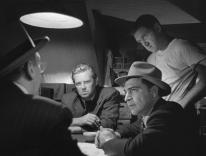Jim Carrey as Scrooge in A Christmas Carol done in 3-D and motion-capture animation? I bah-humbugged on the way to the box office but was surprised and conquered by the flexible faithfulness of Robert Zemeckis’s adaptation. Quite a bit of the Dickensian magic is preserved. Carrey’s vocal performance, an imitation of Alistair Sim in the great 1951 version (but lighter and more skittery than Sim’s line readings), is at least serviceable, but it is Zemeckis’s visual brio that carries the day.
Admittedly, the drawbacks of 3-D rival its advantages. When Christmas Eve snow fell on London, I had the urge to wipe melting flakes from my brow and wrap a woolen comforter around my neck. On the other hand, when poor Bob Cratchit merely moved his hands closer to his desk candle for warmth, I shrank back in my chair to avoid getting throttled. 3-D lends itself to visual hyperbole, and Zemeckis sometimes falls into it, but for the most part, the technology doesn’t overpower the story.
In fact, it was a simple two-shot rather than a special effect that told me this movie was going to be OK. Scrooge draws close to his nephew Fred to ask the hostile question, “Why did you marry?” “Because I was in love.” “Because you were in love,” Scrooge scornfully echoes. But then there is a long pause as he stares at Fred before he dismisses him with “Good afternoon,” and in that pause, in that stare, there is not only scorn but also a certain wonderment and even a touch of envy. That pause gives the miser, who lost the love of his life because of greed, a measure of bitter self-awareness. No technological fireworks here, just canny staging.
Zemeckis’s skill brings an extra charge even to moments that were already sure-fire on the printed page. The transformation of Ebenezer’s doorknocker into Jacob Marley’s countenance catches us off guard because the director delays it while Scrooge fumbles for his key, drops it in the snow, stoops to pick it up, rises, and finally sees the infernally glowing face. And it’s a neat touch to have one of the strongboxes fastened to Marley’s chains hurled into Scrooge’s parlor just before the ghost himself shows up. It’s as if Marley’s very greed were announcing his arrival.
Animation’s facility at instant transformation of objects and people serves one pivotal scene particularly well. When the two wretched children, Ignorance and Want—huddling under the Ghost of Christmas Present’s gown—hear Scrooge’s surprise at their lack of refuge, the boy howls out Scrooge’s earlier selfish words, “Are there no prisons?” and morphs into a knife-wielding mugger, while the girl screams, “Are there no workhouses?” and turns first into a prostitute and then into a madwoman. Precisely because this is done using motion-capture (computerized animation imposed on flesh-and-blood actors), the children retain a certain brutal realism amid all the technological razzle-dazzle.
But the temptation to merely razzle and dazzle is never far away, and Zemeckis occasionally yields to it. The Ghost of Christmas Present changes Scrooge’s room into a sort of hovercraft zipping around London, which makes no sense if the whole point of the episode is that Scrooge learns to walk in the midst of rejoicing humanity. Also, there is a ridiculous chase scene in which the Ghost of Christmas Yet to Come becomes a maniacal coachman trying to run Scrooge over. This bit seems to have escaped from another classic, The Legend of Sleepy Hollow. But these are lapses from a generally solid, occasionally brilliant adaptation.
Most of us would instinctively look away from Claireece “Precious” Jones if we saw her walking down the street in our direction. She is more encased in fat than Scrooge was shrouded in scowls. And her past is more dreadful than the miser’s: repeatedly raped by her father from the age of three and made pregnant by him twice, she has been the constant target of her mother’s verbal and physical abuse for most of her sixteen years. Her obesity is her fortress and her prison. It guarantees the continued derision of her peers and her isolation from society, yet her deadened visage and splayed-toe walk tell us that she has reached a dreadful accommodation with the world: the torments aimed at her mustn’t pierce her armor. Except that they do. Her dream life tells us that this African-American girl wants to be white, this ghetto dweller yearns to be a media celebrity, and this expressionless outsider needs something to take the place of the loving family she’s never had. In the course of Lee Daniels’s film—officially titled Precious: Based on the Novel “Push” by Sapphire (whew!)—the fortress is breached by Ms. Weiss, a social worker; Ms. Rain, an English teacher at an alternative school; and the birth of Precious’s second baby.
Daniels and his scriptwriter, Geoffrey Fletcher, tell this harrowing yet inspirational story well as long as they stay within the bounds of naturalism. The squalor of the girl’s home life and the hopelessness bred there are utterly believable. But the more stylized passages picturing her dreams seem strained and indicate to me that Daniels wasn’t completely in sync with his heroine.
Yes, Precious might well envision herself as a celebrity living in an MTV dazzle, but when the faces in her scrapbook started moving and talking to her like the animated paintings in a Harry Potter movie, I sensed a director showing off. And when Precious, whose reading skills are still rudimentary and whose cultural frame of reference is narrower than a hairline fracture, watches De Sica’s Two Women on TV, she not only imagines her mother as the Sophia Loren character and herself as Loren’s daughter, but mentally rewrites the subtitles in ghetto argot. This is too clever by half and pushes us away from the material.
But the dialogue always rings true; it is sometimes tangily funny and often (when appropriate) obscene. I assume that credit for this must be shared by scriptwriter Fletcher and the cast, whose members seem to be improvising on camera. The black and Hispanic girls in Precious’s alternative school are as lively, as annoying, and, finally, as lovable as the immigrant kids in the French film The Class. Paula Patton makes Ms. Rain a perfect Pygmalion for them, strong and sweet but never treacly.
Daniels has taken three risks with the casting, two of which pay off handsomely, one partially. In regard to the latter, a reputedly well-spoken middle-class girl, Gabourey Sidibe, plays the title role, and Daniels has helped her achieve a mask of truculence, which works for the first two-thirds of the story. To realize fully Precious’s transformation, however, he would have needed an actress of supreme subtlety. Sidibe never transcends the inexpressiveness that must be dispelled at the movie’s climax. Admittedly, that very blankness has its own expressivity throughout much of the movie.
To the rather predictable role of tough but caring social worker, the singer Mariah Carey brings a compelling presence and a speaking voice that purrs, teases, stings, and caresses. A memorable dramatic debut.
But the film’s great performance is given by the stand-up comic Mo’Nique as the mother. There is certainly nothing comic about the role, and she conveys the congealed poison of the woman at full strength. At the beginning of the penultimate scene, when this domestic criminal reveals the roots of her malevolence to the social worker, my heart sank, for I feared that both script and actress were going to take the most obvious route: child abusers are human, too, and now let’s have lots of forgiving tears and hugs ’n’ kisses all round. But no, both the words of the monologue and Mo’Nique’s superb delivery force us to confront the fact that to understand is not necessarily to forgive.
Please email comments to [email protected] and join the conversation on our Facebook page.
Previous Story
Misery Will Never End
Next Story
The Distinctive Christian Tension


